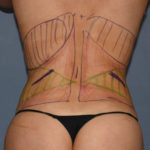Wrong-site surgery is a well recognized problem in the United States. The actual incidence isn’t precisely known, and numbers vary, but it is estimated to be around once in every 100,000 surgeries or so. Most likely the incidence is probably higher. That ratio seems pretty good unless you are that unlucky one amongst the 100,000!
As a result, hospitals in the United States have fairly recently instituted a practice known as ‘surgical marking’. It is now required that the surgeon must first mark the operative site or body part with a surgical marker (ink is hard to get off without alcohol) before they will be taken back to the operating room. Here in Indianapolis at the major hospital chain to which I am affiliated, this practice became the ‘law’ in 2005. In addition, it was also required that the surgeon must speak to the patient before surgery and sign their own operative consents as well. I remember vividly when this change occurred and was somewhat surprised about the great clamor and initial resistance amongst many surgeons.
Two things struck me as odd about surgical marking and its reaction amongst some surgeons. Who wouldn’t want to see their patient’s before surgery (sometimes it is hard to remember someone well if you haven’t seen them in awhile) and why wasn’t such a simple safety step made mandatory decades ago? As a plastic surgeon, the concept of immediate presurgical patient discussion and marking the surgical site has been a routinue practice for as long as I can remember. I can not recall when we didn’t do it. I can also remember many times over the years when I was mildly criticized or joked as…’Let Dr. Eppley finish his doodles before we take him back’…or…’Nice art work..hurry up and get down so we can get going’.

Surgical marking has always been and will always be a critical part of the plastic surgery process. It is a practice that has been standard in plastic surgery since its inception. Wrong site surgery is very rare in plastic surgery undoubtably for this reason. It is about time that the rest of surgical world caught up with this very valuable and simple safety method. It is just a shame that it ultimately required hospitals to make it a mandatory practice.
Dr. Barry Eppley
Indianapolis, Indiana


